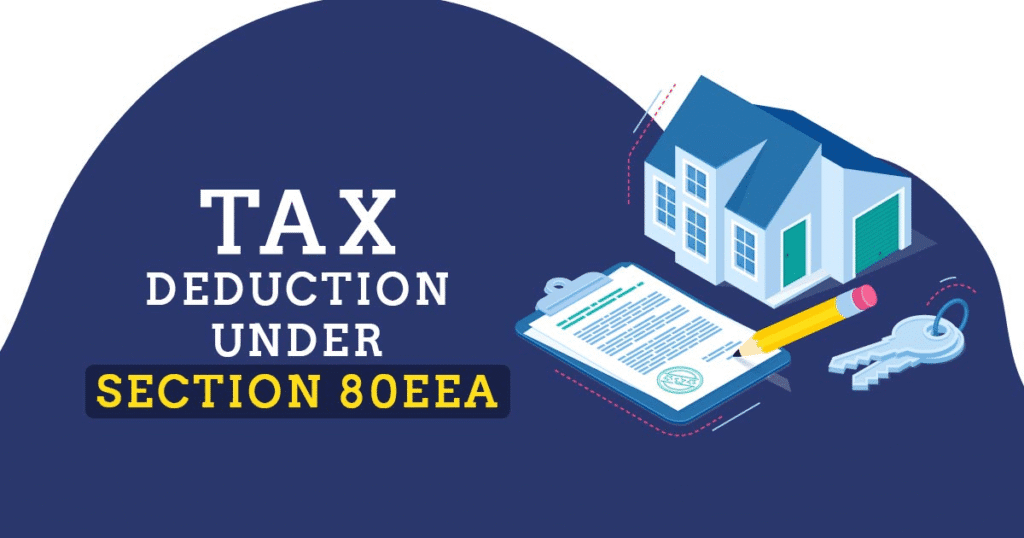
80EEA Deduction:
The 80EEA Deduction offers a valuable opportunity for individuals to reduce their taxable income through specific investments in certain eligible sectors. This deduction can significantly lower tax liability, making it an appealing option for those looking to optimize their financial strategies. With the potential for meaningful tax savings, understanding the nuances of this deduction can empower taxpayers to make informed decisions.
Individuals considering the 80EEA Deduction should be aware of the eligibility criteria and the types of investments that qualify. It primarily targets investments in sectors that contribute to significant growth and development, encouraging taxpayers to participate in the economy while benefiting from tax incentives. By grasping how to navigate this deduction, they can improve their overall financial position.
Exploring the intricacies of the 80EEA Deduction reveals not just the mechanics but also the opportunities it creates for savvy taxpayers. Taking the time to learn about this deduction can lead to substantial financial benefits, enhancing one’s overall approach to taxation and investment.
Understanding the 80EEA Deduction
The 80EEA deduction offers significant financial relief for new homeowners. It provides additional tax benefits specifically on interest payments for home loans, enhancing affordability for first-time buyers.
Eligibility Criteria for 80EEA Deduction
To qualify for the 80EEA deduction, an individual must meet specific criteria. They must be a first-time homebuyer, meaning they cannot have owned any residential property in the past. The property should be a residential house, not exceeding a value of ₹45 lakhs.
The loan must be taken from a financial institution for purchase or construction of the property. The maximum deduction allowed is ₹1.5 lakhs per financial year on the interest paid. It is also essential that the loan is sanctioned between April 1, 2019, and March 31, 2020.
Individuals also need to ensure that their annual income falls under ₹ 2 crores, which allows them to avail of this benefit more easily, contributing to their overall tax savings.
Comparative Analysis: 80EEA and Other Home Loan Tax Benefits
The 80EEA deduction stands out when compared to other home loan tax benefits like Section 80C and Section 24(b). Under Section 80C, borrowers can claim a deduction of up to ₹1.5 lakhs on the principal repayment of the home loan.
In contrast, Section 24(b) offers up to ₹2 lakhs on the interest paid for a self-occupied property.
The 80EEA deduction specifically targets first-time homebuyers with an additional focus on interest payments, which can be more beneficial for those entering the housing market. This makes it an attractive option for new buyers looking to maximize their tax deductions while investing in property.
By providing targeted support, 80EEA encourages homeownership and aims to stimulate the housing sector.
Principles of Home Loans

Home loans are structured financial products that enable individuals to purchase property. Understanding their components, amortization processes, and the importance of credit scores is essential for prospective borrowers.
Components of a Home Loan
A home loan consists of several key components that borrowers must understand:
- Principal Amount: This is the initial sum borrowed from the lender. It is vital for buyers to know how much they need to borrow.
- Interest Rate: This is the rate applied to the principal amount. It can be fixed (unchanging) or variable (subject to change).
- Loan Term: This refers to the duration over which the loan must be repaid, typically ranging from 10 to 30 years.
- Processing Fees: Also known as Mod charges in India, these are fees charged by lenders for processing the loan application. This can vary significantly among financial institutions.
- Equated Monthly Installment (EMI): The monthly payment, which includes both the principal and interest, calculated using the amortization formula to determine the payment schedule.
Loan Amortization Explained
Loan amortization is the process of paying off a loan over time through regular payments.
The loan amortization formula is:
[ EMI = \frac{P \times r \times (1 + r)^n}{(1 + r)^n – 1} ]
Where:
- EMI = Equated Monthly Installment
- P = Loan Principal
- r = Monthly interest rate (annual rate / 12)
- n = Loan tenure in months
Each payment consists of principal and interest components. Initially, payments are predominantly interest, progressively shifting to principal as the loan ages. This schedule helps borrowers understand the cost of borrowing over time.
Understanding Minimum CIBIL Score for Home Loans
The CIBIL score plays a crucial role in securing a home loan. A higher score indicates a lower risk to lenders.
For most financial institutions, including SBI, a minimum CIBIL score of 750 is often required to qualify for a home loan.
A strong credit score increases the chances of loan approval and can lead to better interest rates.
To improve their score, borrowers can:
- Pay existing debts on time.
- Maintain a low credit utilization ratio.
- Check their credit report for errors regularly.
Maintaining a good score is essential for favorable loan terms and conditions.
Mortgages in India

Mortgages in India play a crucial role in financing property purchases and securing loans. Understanding the different types of mortgages, key documents involved, and the meaning of mortgage deeds is essential for prospective homeowners and investors.
Types of Mortgages: Equitable vs Registered
In India, there are primarily two types of mortgages: equitable mortgages and registered mortgages.
- Equitable Mortgage: This type involves a borrower mortgaging their property by depositing the title deeds with the lender. No formal registration is needed, making it quicker and cheaper but potentially riskier for the lender.
- Registered Mortgage: This requires the mortgage deed to be registered with the local sub-registrar. It provides a legal claim over the property and ensures greater security for the lender. Registered mortgages are advisable for larger loans due to their enforceability in courts.
Interpreting Mortgage Deed Meaning
A mortgage deed is a legal document that establishes the relationship between the borrower and the lender.
It outlines the terms and conditions of the mortgage, including:
- Loan amount
- Interest rates
- Repayment schedules
The deed specifies the property being mortgaged and includes clauses related to default and foreclosure. Clarity in the deed is critical, as any ambiguity could lead to disputes.
Key Mortgage Loan Documents
When applying for a mortgage in India, borrowers must provide specific documents. The key documents typically include:
- Identity Proof: Aadhar or PAN card.
- Address Proof: Utility bills or rental agreements.
- Income Proof: Salary slips or income tax returns.
- Property Documents: Title deeds and encumbrance certificates.
- Bank statements: Recent statements to assess financial stability.
These documents are essential to validate the borrower’s identity, creditworthiness, and the property’s legal status before sanctioning the loan.
Property Buying Guide
Navigating the property market can be challenging, especially for those with low income. This guide focuses on essential elements such as the home buying process, legal documentation, and the importance of property rates.
Steps to Buying a House with Low Income
- Assess Financial Situation: Identify income, expenses, and potential savings. This helps in determining the budget for buying a home.
- Explore Financing Options: Look into government schemes, grants, or low-interest loans available for low-income buyers. Programs like the Pradhan Mantri Awas Yojana may be relevant in certain regions.
- Get Pre-approved for a Mortgage: Contact lenders to understand eligibility and secure pre-approval for a loan. This will clarify the budget and strengthen negotiating positions.
- Search for Affordable Properties: Use online platforms and local listings to find properties within budget. Consider areas with lower costs per square foot.
- Negotiate the Price: Leverage any market research to negotiate better deals. Having a pre-approval can provide leverage in price discussions.
- Complete the Paperwork: Be prepared for various forms, especially if applying for special financing. Documentation must be accurate and timely.
Understanding the Conveyance Deed
A conveyance deed is a critical legal document required in property transactions. It signifies the transfer of ownership from the seller to the buyer.
Key components include:
- Identification of Parties: The deed must clearly state the seller and buyer’s identities.
- Property Description: Detailed information about the property, including boundaries and location, must be included.
- Consideration Amount: This indicates the price paid for the property, which may influence tax liabilities.
Proper registration of the conveyance deed is crucial. Failing to register can lead to disputes and issues regarding ownership rights. For this reason, engaging with legal counsel to review the deed is advisable.
Significance of the Circle Rate in Property Transactions
Circle rates are baseline property prices set by local authorities. They help in determining the minimum value at which properties can be sold within a specific area.
- Tax Implications: Transactions below the circle rate may attract scrutiny from tax authorities, leading to potential penalties.
- Market Value Indicator: Circle rates can reflect the general market trend, providing insight into property valuation.
Understanding circle rates helps buyers gauge if they are paying a fair price. It is vital to consult local guidelines as these rates vary by location and property type. Engaging in due diligence will promote a transparent transaction process.
Home Loan Management Strategies
Effective management of home loans involves several key tactics. These strategies help borrowers save on interest, transfer loans when necessary, and navigate potential foreclosure charges.
Reducing Home Loan Tenure Effectively
Reducing the tenure of a home loan can significantly lower the total interest paid over time. Borrowers should consider making higher monthly payments or one-off prepayments.
Adjusting the loan tenure can also be a useful way to enhance financial discipline. For instance, opting for a shorter term loan can lead to savings on interest due to the reduced length of the loan.
Example of Interest Savings:
| Tenure (Years) | Loan Amount (INR) | Interest Rate (%) | Total Interest Paid (INR) |
| 20 | 50,00,000 | 8.5 | 39,77,555 |
| 15 | 50,00,000 | 8.5 | 30,09,969 |
This demonstrates the financial benefit of a shorter tenure.
Home Loan Transfer Procedures
Transferring a home loan from one lender to another can lower interest rates and overall costs. This process involves applying with the new lender while ensuring the current home loan is paid off.
Necessary documents typically include identity proofs, income statements, and loan statements from the existing lender. It is crucial to check the transfer fees associated with the change.
Borrowers should also assess any benefits from promotional offers provided by the new lender. Understanding the terms of the new home loan agreement is essential before making the switch.
Foreclosure Charges and How They Vary
Foreclosure charges can differ significantly among banks and Non-Banking Financial Companies (NBFCs) in India. These charges often apply if the borrower settles the loan before its term.
Generally, lenders may charge between 1% to 4% of the outstanding principal as a foreclosure fee. Many banks offer reduced charges if the foreclosure is completed within a specific period.
Foreclosure Charge Overview:
| Lender Type | Foreclosure Charge (%) |
| Public Sector Banks | 0% – 2% |
| Private Banks | 2% – 4% |
| NBFCs | 1% – 3% |
Knowing these charges can help borrowers make informed decisions regarding letting go of their home loans early.
Government Initiatives and Schemes

Government initiatives in housing aim to make home ownership more accessible, especially for the economically weaker sections. Various programs and schemes offering financial support and subsidies play a key role in this endeavor.
Comprehensive List of Housing Schemes
The government has introduced several housing schemes to support various segments of society. Notable schemes include:
- Pradhan Mantri Awas Yojana (PMAY): Focuses on affordable housing for urban and rural poor. It provides subsidies on home loans.
- Credit Linked Subsidy Scheme (CLSS): Offers interest subsidies for home loans to first-time buyers.
- Housing for All by 2022: Aims to provide affordable housing to all citizens, promoting public-private partnerships.
- State-Specific Schemes: Many states have their own housing initiatives targeting local needs, such as the Mukhyamantri Awas Yojana in several states.
These schemes help streamline the process of acquiring a home, making it more feasible for lower-income families.
Overview of Government Home Loan Schemes
Government home loan schemes are designed to ease financial barriers for potential homeowners. These include:
- Interest Subsidy Programs: Government provides a percentage of the interest as a subsidy, reducing the burden on borrowers.
- Longer Loan Tenures: Enhanced tenures for repayment allow borrowers to manage finances better.
- Loan Guarantees: In certain cases, the government offers guarantees to lenders, encouraging them to offer loans to deserving candidates.
- Low-Interest Loans: The government collaborates with banks to offer loans at lower interest rates, enhancing affordability.
These home loan schemes create a supportive environment for those looking to buy homes, fostering economic growth and stability.
Additional Considerations in Home Buying
Home buying involves several factors beyond the property itself. Important elements such as the role of loan guarantors, tax implications, and sustainable building practices contribute to a comprehensive understanding of the process.
Role of Loan Guarantors
A loan guarantor can enhance a buyer’s mortgage application by providing additional financial security to lenders. Typically, a guarantor is someone with a strong credit history and a stable income.
Key points about loan guarantors include:
- Responsibility: They are responsible for the loan if the borrower defaults.
- Income Verification: Lenders often require proof of the guarantor’s income and creditworthiness.
- Limitations: Not all lenders accept guarantors, and rules can vary significantly.
Potential buyers should understand these rules when considering a loan guarantor’s role in their mortgage application.
GST Implications for New Properties
When purchasing new properties, the Goods and Services Tax (GST) applies and can significantly influence overall costs.
Important aspects of GST for new flats include:
- GST Rate: Usually set at 18% for new residential properties.
- Input Tax Credit: Buyers may claim input tax credit for the GST paid on construction services.
- Registration: Developers must be registered under GST to pass on this tax correctly.
Being aware of these implications can help buyers make informed financial decisions throughout the purchasing process.
Employing Green Construction Materials
Incorporating green construction materials into home building offers both environmental and economic benefits.
Considerations regarding green materials include:
- Sustainability: Materials like bamboo, recycled steel, or reclaimed wood reduce environmental impact.
- Energy Efficiency: Homes built with these materials often qualify for energy-efficient ratings, impacting resale value.
- Incentives: There may be financial incentives or rebates available for homes using sustainable materials.
Awareness of these options allows buyers to participate in environmentally friendly practices while also enjoying long-term savings.
Documentation and Compliance
Proper documentation is crucial for claiming the 80EEA deduction. Ensuring compliance with tax regulations can streamline the process and minimize issues.
Utilization of Form 16
Form 16 serves as a vital document for taxpayers. It is a certificate issued by employers that summarizes the tax deducted at source (TDS) on salary.
Taxpayers can use Form 16 to verify their income and tax deductibility. For the 80EEA deduction, it provides clarity on the salary earned, which is essential in determining eligibility.
In addition, Form 16 contains details of deductions claimed during the financial year. This information confirms compliance with tax laws, ensuring that the deduction is claimed accurately.
Taxpayers should retain this document for their records and future reference. It plays a significant role in substantiating tax returns submitted to the income tax department.
